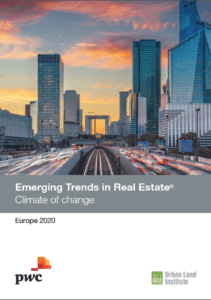Despite the political uncertainty across Europe and around the world, European real estate remains a desirable asset for investors globally. That is the bottom line of the new Emerging Trends in Real Estate® Europe 2020 report released by the Urban Land Institute with PwC in Brussels. At the same time, the industry is experiencing significant changes impacted by technology, regulation, and climate. This environment is what inspired this year’s theme: climate of change.
At the BNP Paribas Fortis office on Rue de la Chancellerie in central Brussels, ULI Europe CEO Lisette van Doorn presented the report, which is now in its 17th year and includes input from 900 industry leaders.
Pressing Issues
The experts’ main concern is political instability at the regional and national levels.
“This year, political risk is hitting us, and for the first time in years economic growth being impacted negatively by trade tensions, which is leading to renewed monetary expansion,” van Doorn explained. “At this point last year, everybody thought interest rates would stay stable, and that has changed dramatically in the meantime.”
This environment is leading to ongoing strong investor interest in income return and therefore real estate. Already for a couple of years, this is leading to a lack of availability of suitable ‘core’ assets, which is leading to a growing interest for development. However, the bar for development is higher today, one expert said. More than two-thirds of survey respondents—more than last year—cited increasing construction costs as the biggest concern for their business in 2020.
And we seem to have reached an environmental tipping point. “It’s not only about climate mitigation, it’s about true adaptation to climate change,” van Doorn said. Cities are highly exposed to climate change risks, but the real estate market is just beginning to evaluate that.
Europe’s Top10 Cities for Investment
The coming 2024 Olympic Games were cited as a big draw for Paris, drawing the top ranking for this year, but the Grand Paris project was also mentioned many times by experts as a pull. The €26 billion infrastructure project is a fundamental redrawing of Paris’s transit system, which will open up new areas of the city. “It will change the way the city works for good. It is a tangible example of how transportation can directly influence investment as an incubator for new markets,” one respondent said.
Berlin was ranked as number two, and Frankfurt, Munich, and Hamburg also remain in the top 10. “People think Germany’s become very expensive, but it’s still seen as a safe bet,” van Doorn said.
London came out at as fourth four in the ranking. While many investors remain cautious and pause activity following ongoing uncertainty around Brexit, London continues to be seen as a favored long term investment location . “It would be quite gutsy to invest in London over the coming year,” a German institution said. At the same time, “London has staying power. London has culture, it has arts and education, it has a rule of law,” a global investment banker said.
ResidentialRules
Six of the 10 most promising sectors for 2020 are related to residential. “If there is a megatrend in urbanization, and people still flock to big cities, then there is demand for housing, and for affordable housing,” one global pension fund manager said.
Affordable housing was among the top 10 sectors forthe first time. Some 61 percent of respondents said that they are concernedabout housing affordability in 2020—up from last year—and half believe that theproblem will worsen over the next five years.
But the residential sector also faces high political risk. Many interviewees cited the decision by Berlin’s impending rent controls as an example of how political pressures can affect financial returns. Barcelona and London also are considering rent regulations. ULI is working on a study on affordable housing solutions, said van Doorn. Good examples of how to deliver more affordable housing under the current challenging circumstances do exist, for example related to modular construction, financial incentives, and closer collaboration between public and private sectors, and it is important to share these.
A Focuson Mobility
“Mobility for an investor or developer used to be a given,” van Doorn said, and that is why chapter 4 of the report is devoted to it. However, with the emergence of micro mobility this is changing rapidly.
Cities are becoming polycentric, and suburbs arebecoming better connected. An overwhelming majority (92 percent) of surveyrespondents agreed that “smart mobility solutions should be an integral part ofany urban [re]development project.”
Individual property owners are pursuing partnerships with mobility companies to encourage shared cars, bikes, and scooters rather than personal automobiles. But cities and regions are also investing more in people-powered mobility, which is not only helpful for the environment but also healthful for people.
At the same time, investors are already starting to thinking about the future of personal mobility—with electric flying taxis, autonomous vehicles, and hyperloops. But, as is often the case, the first practical applications are coming from logistics. Since van deliveries are on the rise, pollution and congestion have become an issue in European cities. Some cities and developers are creating centralized distribution centers or coordinating shipments locally to help solve the last-mile problem.
Discussing the Findings
After van Doorn’s presentation, Benjamin Cadranel, CEO of Citydev and board member of ULI Belgium, led a panel discussion with a number of senior real estate experts.
Despitepessimistic views in the report, Serge Fautré, CEO of AG Real Estate, is stillkeen on retail. His company’s shopping centers in Belgium have occupancy ofclose to 100 percent, and “they’re being renovated one after another,” he said.The issue is, “People talk about experience shopping, but nobody knows what itis. In Belgium, it is eating.” But on a more serious note, Fautré said that hebelieves that infrastructure needs to be considered as an asset class. “There’sa crucial lack of infrastructure investment in every European city,” he said,which needs to be tackled by public/private partnerships.
Residentialis of particular interest to Kari Pitkin, head of business development atAllianz Real Estate. Globally, her company has $2 billion invested in studentbuild-to-rent. “As landlords, we need to be more aware of the end user of ourassets, as opposed to the person signing the lease,” she said.
CraigHughes, global real estate leader at PwC, agreed about designing for users. “Weneed to think as much about people as we do about the assets. An asset only hasa value if somebody wants to use it, enjoys it, would like to have it,” hesaid. Doing that will require the industry embracing technological changes morequickly.
ButGabriel Uzgen, CEO of Besix RED, warned against tech for tech’s sake.“Innovation should be a means and not a purpose,” he said. “Innovation in realestate is present in every part of the development process, but people shouldbe at the forefront of our thoughts.”


